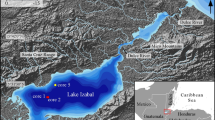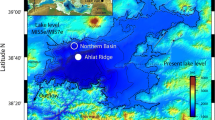Abstract
In a sediment sequence from Erlongwan maar lake that spans the last 13 ka BP, two main varve types can be recognized: biogenic varves (from the present to ∼11.2 ka BP, 0–632 cm) and clastic varves (from ∼11.2 to ∼12.7 ka BP, 632–700 cm). Based on the dominant types of algae contained in the sediment, the biogenic varves can be classified into dinocyst-biogenic varves (0–63 cm) and mixed (dinocyst and diatom)-biogenic varves (214–632 cm). In this paper, the formation process and components of the varve are described, the possible reason for the types of varve changing throughout the record is discussed and a high-resolution varve chronology is established spanning the last 13 ka BP. Although further varve counting and error assessment are needed, the results presented here represent a solid foundation for studying the palaeoclimate record of Erlongwan maar lake.
Similar content being viewed by others
References
Liu J Q, Liu T S, Chu G Q et al. Maar lake and varve chronology. Quat Sci (in Chinese), 1996, (4): 353–358
Shen J, Liu X Q, Wang S M, et al. Palaeoclimatic changes in the Qinghai Lake area during the last 18000 years. Quatern Int, 2005, 136: 131–140
Brauer A, Negendank J F W. The value of annually laminated lake sediments in Palaeoenvironment reconstruction. Quatern Int, 2002, 88: 1–3
Liu J Q, Lu H Y, Negendank J F W, Mingram J, et al. Periodicity of Holocene climate variations in the Huguangyan maar lake. Chin Sci Bull, 2000, 45(18): 1712–1717
Li W C, Li S J, Pu P M. Review on the high resolution varved lake sediments as a proxy of paleoenvironment. Adv Earth Scis (in Chinese), 1999, 14(2): 172–176
Saarnisto M. Annually laminated lake sediments. In: Berglund B E, ed. Handbook of Holocene Palaeoecology and Palaeohydrology. New York: John Wiley & Sons Ltd, 1986. 343–370
Zolitschka B, Brauer A, Negendank J F W, et al. Annually dated late Weichselian continental paleoclimate record from the Eifel, Germany. Geology, 2000, 28(9): 783–786
Liu Q, You H T, Liu J Q. Methodology of studying on varved lake sediments and its significance. Quat Sci (in Chinese), 2004, 24(6): 683–694
Michel J M. An overview of climatic variability and its casual mechanisms. Quatern Res, 1976, 6: 481–493
Kemp A E S, Baldauf J G, Pearce R B. Origins and palaeoceanographic significance of laminated diatom ooze from the Eastern Equatorial Pacific Ocean. In: Kemp A E S, ed. Palaeoclimatology and Palaeoceanography from Laminated Sediments. London: Geological Society Special Publication. No 116, 1996. 243–252
O’sullivan P E. Annually-laminated lake sediments and the study of Quaternary environmental changes—A review. Quat Sci R, 1983, 1: 245–313
Anderson R Y, Dean W E. Lacustrine varve formation through time. Palaeogeo P, 1988, 62: 215–235
Mingram J, Allen J, Brüchmann C,et al. Maar and crater lakes of the Long Gang Volcanic Field (N.E.China)-Overview, laminated sediments, and vegetation history of the last 900 years. Quatern Int, 2004, 123–125: 135–147
Mingram J, Negendank J F W, Brauer A, et al. Long cores from small lakes—recovering up to 100 m-long lake sediment sequences with a high-precision rod-operated piston corer (Usinger-corer). J Paleolimnol, 2007, 32: 517–528
You H T, Liu Q, Liu J Q, et al. Research methodology prelimimary results for varved lacustrine sediments of the Sihailongwan maar lake. Earth Environ (in Chinese), 2006, 34(2): 71–76
Frank U. Rock magnetic studies on sediments from Erlongwan maar lake, Long Gang Volcanic Field, Jilin Province, NE China. Geophy J Int, 2007, 168(1): 13–26
Reimer P, Baillie M G L, Bard E, et al. Intcal04 terrestrial radiocarbon age calibration, 0–26 cal kyr BP. Radiocarbon, 2004, 46(3): 1029–1058
Chu G Q, Gu Z Y, Xu B, et al. Varve chronology and radiometric dating (137Cs, 210Pb) from the Sihailongwan maar, Northeastern China. Quat Sci (in Chinese), 2005, 25(2): 202–207
Chu G Q, Sun Q, Rioual P, et al. Dinocyst microlaminations and freshwater “red tides” recorded in Lake Xiaolongwan, northeastern China. J Paleolimnol, 2007(in press), doi: 10.1007/s10933-007-9106-1
You H T, Liu Q, Liu J Q. A comparative study on model sedimentation rates with varve dating, 137Cs and 210Pb dating in Erlongwan maar lake, NE China. J Jilin Univ (Earth Sci Edition) (in Chinese), 2007, 37(1): 59–64
Author information
Authors and Affiliations
Corresponding author
Additional information
Supported by CAS Key Project (Grant No. KZCX3-SW-145) and the National Natural Science Foundation of China (Grant No. 4032014043)
About this article
Cite this article
You, H., Liu, J., Liu, Q. et al. Study of the varve record from Erlongwan maar lake, NE China, over the last 13 ka BP. Chin. Sci. Bull. 53, 262–266 (2008). https://doi.org/10.1007/s11434-007-0448-x
Received:
Accepted:
Issue Date:
DOI: https://doi.org/10.1007/s11434-007-0448-x




